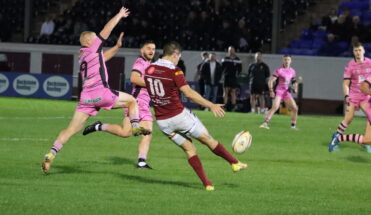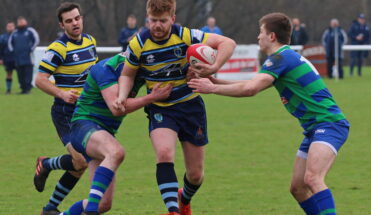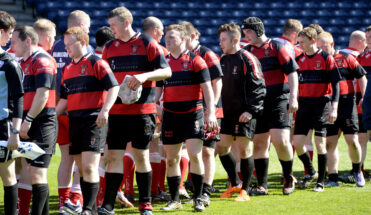IN CONVERSATION WITH… Jamie Ritchie
Back-row Jamie Ritchie is one of seven players to start every Test match in the Guinness Six Nations so far.
In the autumn he was among the six try scorers in the national team’s biggest victory over Fiji to date, making 42 tackles (the third best), taking the second-most lineout ball and topping the team’s turnover stats for the campaign.
Ritchie’s first five Scotland starts saw him alternate between six and seven game-to-game and at ‘6 foot four and a bit’ he certainly has the height – coupled with athleticism and mobility – to make the most of these different opportunities.
We caught up with the 22-year-old to ask how he’s settling into the role of Test match flanker.
Scotland play a high energy, high tempo, physically-demanding game, which asks a lot of the players. It strikes me that suits you?
“I’ve never been a massive bruiser – the kind with a big physical presence on the pitch but I get through my work and am reasonably physical in defence but that’s not my game.
“I’m quite lucky in that I’ve a decent work-rate and consider myself reasonably fit, so a faster looser game is arguably more suited to me personally.”
Do you feel your skills and your physical attributes mean you offer variety? You’re an option in the lineout, kick-chase – the lung stretching stuff – as well as jackling over and stealing ball.
“The breakdown has always been an area I think I’m quite good at. Since I moved to the back-row [Jamie was a stand-off and centre in his younger years] it’s been something I enjoy – trying to get over ball.
“The difference comes when you move into senior rugby. I found in my earlier days that I was being hit off that ball by heavier guys, especially if I wasn’t in a good position earlier or wasn’t as strong.
“It’s a part of my game that I’ve worked on quite a lot, especially since the summer tour, and have prided myself on this year. It’s been good to see it come into my game more and more.
“The lineout has always been a strength of mine. Being quite tall and reasonably explosive allows me to get up there and compete for ball.
“When I’m playing seven, I think my lineout work is definitely something that adds something, if you’ve got someone who can jump in the lineout at six and eight, having a seven that can do that too gives you more options.
“For me it’s just about doing as much as I can and put as many strings into my bow.”
Let’s talk about competing for ball at the breakdown. What are your triggers? Are they different as a taller guy?
“It’s something that you feel in the moment.
“It helps if someone makes a decent tackle in front of you allowing you to really attack the ball, that’s probably the biggest trigger for me.
“Sometimes you find in games that, in critical points, you just try and go for everything on the off chance you can get it but that’s also something that I’ve had to work on because, in the past, I occasionally got caught out trying to go for too much.
“When you do that you risk leaving space elsewhere by chasing dead rucks, so my I’ve worked a lot on my decision making in that area, which has been credit to guys like Peter Wilkins [ex-Edinburgh defence coach] and Kitty [Callum] MacRae [Edinburgh defence coach].
“It’s a part of my game that’s hopefully improved quite a lot.
“If there’s a clear-cut opportunity to get the ball then definitely go for it but you must bear in mind that you may put the team under pressure elsewhere.
“What that means is that, if you’re going for it, you go for it 100%.”
Head Coach Gregor Townsend has reflected frequently on how highly he values cohesion, which in itself can be good illustration of the subtleties of the units within the team.
“You look at guys who have played together for a long time – Magnus Bradbury and I have played together since Scotland U18, we’re used to each other well.
“He’s a big carrier, his kick-chase is good and he’s physical in defence, so even within the team structure you can swap – i.e. attacking and defensive lineouts – because of what each of us do well.
“It’s the ability to change and adapt within systems that allow us to perform – sometimes looking a phase ahead and allowing one another to get to certain positions first because of our strengths.”
What’s next? What are your work-ons now?
“The core parts of my game are important to me and are the ones I’ll always work on.
“After every session I’ll grab someone and do ten good passes off each hand to keep my skill level up.
“I’ll always do jackling after a session in the week and work on areas within sessions that allow me to practice these skills, like getting into positions that would allow me to get on to the ball to get into good habits.”
![[[+name]]](https://d2m3fcf8oort3z.cloudfront.net/assets/galleries/jamieritchie8.jpg)
![[[+name]]](https://d2m3fcf8oort3z.cloudfront.net/assets/galleries/jamietichie7.jpg)
![[[+name]]](https://d2m3fcf8oort3z.cloudfront.net/assets/galleries/jamieritchie1.jpg)
![[[+name]]](https://d2m3fcf8oort3z.cloudfront.net/assets/galleries/jamieritchie3.jpg)
Related Fanzone

Review of Round 2 | Super Series Sprint

Ireland v Scotland Women | Preview

Podcast: Rachel Malcolm | One to one with Caroline Blair

Guide to the Games | Round 2

WATCH LIVE: 2024 Silver Saturday

Silver Saturday preview: Scottish Cup final: Edinburgh Academical v Hawick

Silver Saturday preview: Sarah Beaney Cup: Watsonians v Hillhead Jordanhill

Silver Saturday Preview: Men’s League Cup final: Lasswade v Falkirk


Watch: Rise Now | Bounce back in Parma





